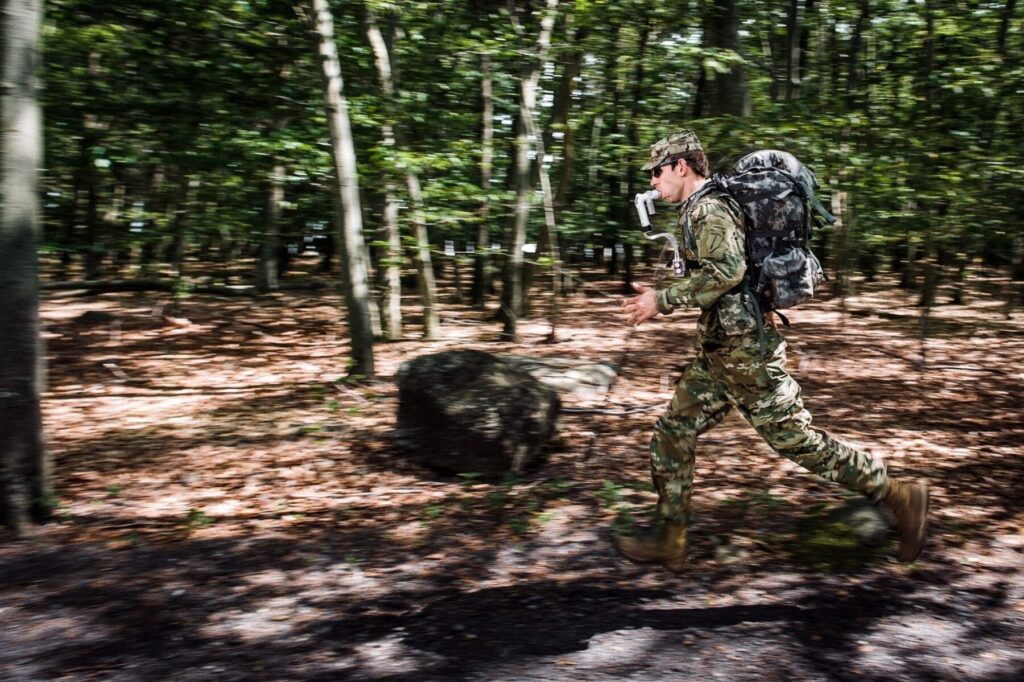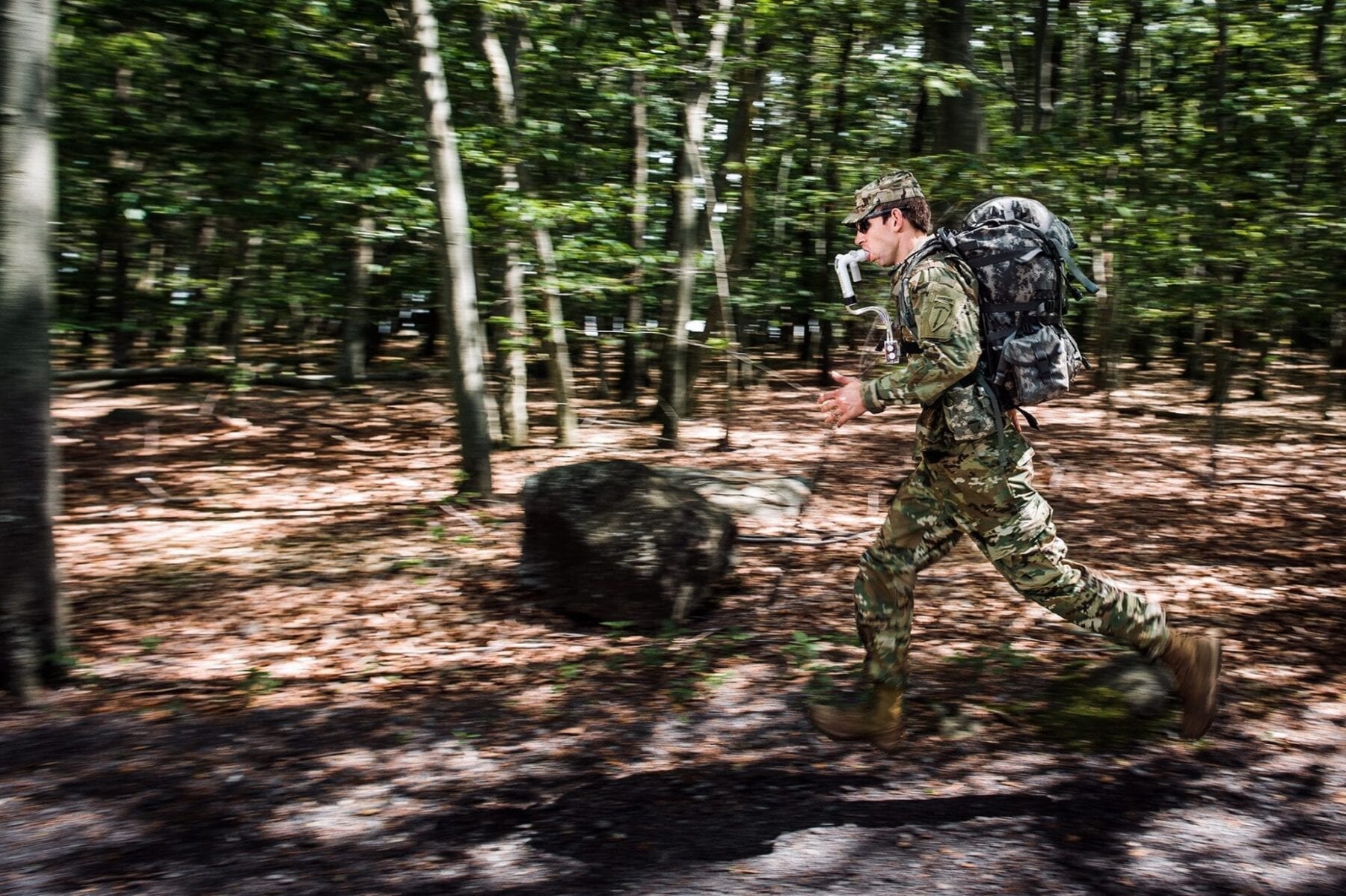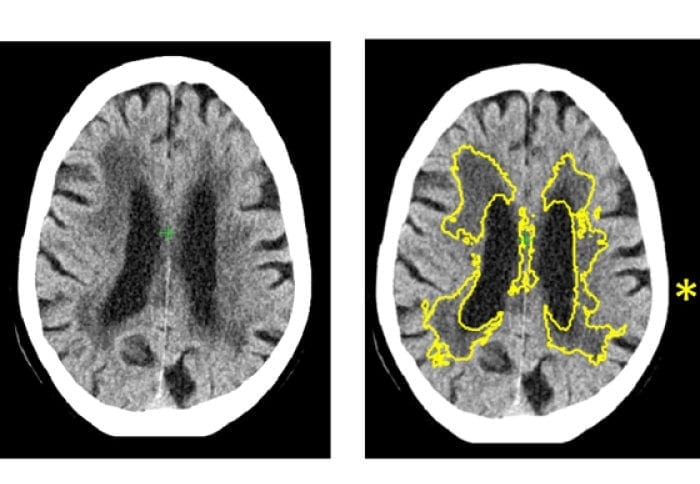
Simple-to-use, low-cost respiratory sensor enables measurement and tracking of personal metabolism.
The military has great interest in more comprehensive measurement and tracking of metabolism, both for optimizing the performance of warfighters under demanding physical conditions and for maintaining the health and wellness of their forces during and after their military careers. While sensors for making metabolic measurements have existed for decades, they are expensive, cumbersome instruments primarily intended for clinical or professional use. MIT Lincoln Laboratory, in collaboration with the U.S. Army Research Institute of Environmental Medicine (USARIEM) and the Marine Expeditionary Rifle Squad (MERS), has undertaken a research effort to create a low-cost personal metabolic sensor and an associated metabolic fuel model. The Carbon dioxide/Oxygen Breath and Respiration Analyzer (COBRA) enables individuals to make on-demand metabolic measurements simply by breathing into it.
“Besides assessing performance of soldiers in the field, the COBRA can be applied to broader purposes, such as training athletes for high-endurance activities, guiding weight loss by quantifying the impact of dietary and exercise regimens, or identifying nutritional imbalances,” said Kyle Thompson, a member of the development team from Lincoln Laboratory’s Mechanical Engineering Group.
Since the early 20th century, scientists have been using indirect calorimetry (IC) to calculate individual energy expenditure and metabolic rates. This method measures the ratio of carbon dioxide to oxygen in exhaled breath, which can be used to measure the levels of carbohydrates and fats being used by the body to meet metabolic energy needs. Information about energy expenditure rates is valuable for setting reasonable physical standards within the military. For example, limits on the distance and speed of foot marches can best be established by quantifying metabolic workloads of soldiers. The Soldier 2020 program is currently employing metabolic energy measurement to help establish job-related fitness requirements.
“For high-performance athletes or active-duty soldiers, optimally matching nutritional intake to the demands of a specific activity can improve performance and increase the likelihood of successful mission completion,” said Gary Shaw, principal investigator on the Laboratory’s COBRA team. Physically demanding tasks can lead to glycogen depletion, which has a negative impact on performance. By tracking energy expenditure in real time, soldiers could detect and avoid the onset of low glucose levels associated with glycogen depletion as well as other metabolic complications, such as heat stress.
While existing mobile IC sensors can make physiological measurements, they are expensive and complex to calibrate; consequently, their application has largely been limited to clinical studies, high-performance athletics, and field testing with small groups of subjects over limited periods of time. The COBRA sensor is smaller, simpler to use, and less costly to manufacture than existing IC sensors, enabling the measurement of individual energy expenditure for dozens of soldiers in a military field unit throughout the day. Lincoln Laboratory researchers hope to use such measurements to refine the personalized metabolic fuel model for individuals, track nutritional needs, and assess the impact of training on the individual’s metabolic efficiency and endurance.
 The COBRA sensor is more portable and cost-effective than existing indirect calorimetry sensors. It includes a chest harness and bite grip that enable hands-free use of the system during exercise and training.
The COBRA sensor is more portable and cost-effective than existing indirect calorimetry sensors. It includes a chest harness and bite grip that enable hands-free use of the system during exercise and training.
“The COBRA system is a breakthrough technology that promises to provide performance comparable to $30,000–$40,000 sensors at a fraction of the cost and with ease of use that makes personal ownership feasible,” said Shaw.
USARIEM is currently testing and evaluating the COBRA sensor by comparing the COBRA measurements against those collected by laboratory-grade instruments. Once the sensor performance has been benchmarked in the laboratory, USARIEM will conduct small field studies to measure energy expenditure and nutrient consumption associated with different training exercises. Following successful field measurements, low-rate production of the COBRA sensor may be pursued in order to study energy expenditure and performance across dozens of soldiers over days of activity.
Beyond its use in studies of the performance of soldiers and athletes, the COBRA sensor and associated metabolic model can be applied to the management of the general population’s metabolic health. It is anticipated that the COBRA sensor and metabolic model can be used to tailor dietary and exercise regimens for managing weight, inferring blood glucose and glycogen storage levels, and creating public databases on metabolic wellness and trends. This information could be used by clinicians and patients to aid in controlling obesity, which affects over one-third of Americans, and to provide a non-invasive indication of chronically high blood glucose, which is associated with the development of type-2 diabetes. According to the Centers for Disease Control and Prevention, nearly half of the adult population in the United States is either diabetic or pre-diabetic.
There are several promising avenues for the COBRA sensor’s future. The researchers have applied for a patent and plan to conduct single-subject experiments to demonstrate how the sensor can be used in assessing nutritional imbalances. The Laboratory will also seek opportunities to collaborate with other researchers interested in using COBRA as a tool in clinical studies, including those concerned with weight loss and endurance training.
Learn more: Monitoring metabolic energy expenditure, health, and fitness with a breath analyzer
The Latest on: Personal metabolic sensor
[google_news title=”” keyword=”personal metabolic sensor” num_posts=”10″ blurb_length=”0″ show_thumb=”left”]
via Google News
The Latest on: Personal metabolic sensor
- Personal Financeon April 25, 2024 at 5:00 pm
Mortgage rates fluctuate almost daily based on economic conditions. Here are today’s mortgage rates and what you need to know about getting the best rate. The cost of raising a child in the U.S ...
- Personal Financeon April 18, 2024 at 5:00 pm
The founder of Her First $100K explains the importance of loud budgeting, pay transparency, and teaching girls about money. We sell different types of products and services to both investment ...
- How to Get a $3,000 Personal Loan (April 2024 Guide)on April 2, 2024 at 4:59 pm
Cheri Read is a former accountant turned professional personal finance writer. As someone who struggled as a single mom for many years, she’s passionate about helping others tame their finances ...
- Forget Ozempic, is this arm implant the future of weight loss and healthy living?on March 28, 2024 at 10:49 am
One such gadget is the Lingo biosensor, which brands itself as “your personal metabolic coach”. The sensor works by being painlessly injected into the back of the arm (you basically punch it ...
- Personal Financeon March 28, 2024 at 6:40 am
CNBC Select is your go-to source for everything you need to know about managing your personal finances, including reviews on budgeting apps, advice on how to save money and tips to make debt ...
- Personal Loanson March 10, 2024 at 5:01 pm
Blueprint is an independent, advertising-supported comparison service focused on helping readers make smarter decisions. We receive compensation from the companies that advertise on Blueprint ...
- Personal Loanson March 20, 2023 at 8:34 am
Compare the Best Personal Loans To Find One That’s Right For You ...
- Personal Financeon February 4, 2023 at 7:41 pm
When you need to borrow money, you may decide between a personal loan vs line of credit. Learn the pros and cons of each and which one is right for you.
- Simple Seismic Sensor Makes Earthquake Detection Personalon October 28, 2019 at 9:59 pm
It’s just a simple sensor for detecting ground vibrations, whether they be due to passing trucks or The Big One. [Alex] lives in California, wedged between the Hayward, Calaveras, and San ...
via Bing News











